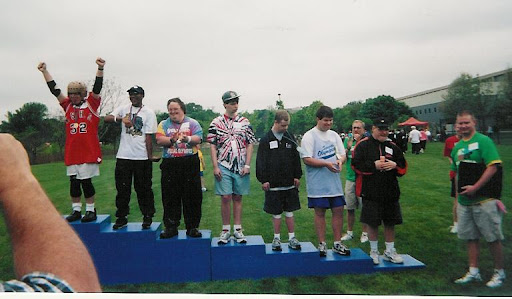Williams Syndrome according to DSM4
Williams Syndrome
Williams Syndrome (WS) is a genetic disorder associated with mental retardation (MR) and a distinct behavioral phenotype including a friendly and outgoing personality. This population, like others with MR, has been reported to have an increased rate of symptoms of mental illness; however, few studies have used DSM-IV criteria to quantify specific psychiatric diagnoses in WS and the prevalence of psychiatric illness in relatives of individuals with WS and the possible relationship between family and patient diagnoses is currently unknown.
Reference is Dykens EM.Psychopathology in children with intellectual disability.Child Psychol2000;41:4
07-17 and JefrsonJournal of Psychiartry,Volum 20Number 1 on the web:jdc. jefferson.edu/jeffry
psychiatry
Williams syndrome
Williams syndrome (WS or WMS; also Williams–Beuren syndrome or WBS) is a rare neurodevelopmental disorder caused by a deletion of about 26 genes from the long arm of chromosome 7.[1] It is characterized by a distinctive, "elfin" facial appearance, along with a low nasal bridge; an unusually cheerful demeanor and ease with strangers; developmental delay coupled with unusual (for persons who are diagnosed as developmentally delayed) language skills; and cardiovascular problems, such as supravalvular aortic stenosis and transient hypercalcaemia. The syndrome was first identified in 1961 by Dr. J. C. P. Williams of New Zealand[2] and has an estimated prevalence of 1 in 7,500 to 1 in 20,000 births.[1
Signs and symptoms
The most common symptoms of Williams syndrome are mental disability, heart defects, and unusual facial features. Other symptoms include failure to gain weight appropriately in infancy and low muscle tone. Most individuals with Williams syndrome are highly verbal and overly sociable, having what has been described as a "cocktail party" type personality, and exhibit a remarkable blend of cognitive strengths and weaknesses. Individuals with WS hyperfocus on the eyes of others in social engagements.[3] Patients tend to have widely spaced teeth, a long philtrum, and flattened nasal bridge.[4] Individuals with Williams syndrome also experience many cardiac problems, commonly heart murmurs and the narrowing of major blood vessels as well as supravalvular aortic stenosis. Other symptoms may include many gastrointestinal problems, such as abdominal pain and diverticulitis, as well as hormone problems, the most common being hypercalcemia (elevated calcium levels in the blood). Hypothyroidism has been reported to occur in children, although there is no proof of it occurring in adults; diabetes has been reported to occur in adults with WS as young as 21 years old.[5
Because of the multiple genes that are missing in people with Williams syndrome, there are many effects on the brain, including abnormalities in the cerebellum, right parietal cortex, and left frontal cortical regions. This pattern is consistent with the visual-spatial disabilities and problems with behavioral timing often seen in Williams syndrome. Frontal-cerebellar pathways are involved in behavioral timing, and the parietal-dorsal areas of the neocortex handle visual processing that supports visual-spatial analysis of the environment (but not faces). People with Williams syndrome are often affable and hyperverbal – often blurting – which demonstrates the decreased inhibition ability that stems from dorsal-frontal deficits.[13] There have also been studies that show that the amygdala of a person with Williams syndrome has greater volume than the average person's, and given that the amygdala controls a human's sense of fear, it can be seen why WS individuals can so willingly talk to anyone, including strangers.[14]
Cause
Williams syndrome is caused by the deletion of genetic material from the region q11.23 of chromosome 7. The deleted region includes more than 25 genes, and researchers believe that the loss of several of these genes probably contributes to the characteristic features of this disorder. Researchers have found that loss of the ELN gene, which codes for the protein elastin, is associated with the connective-tissue abnormalities and cardiovascular disease (specifically supravalvular aortic stenosis and supravalvular pulmonary stenosis) found in many people with this syndrome. Studies suggest that deletion of LIMK1, GTF2I, GTF2IRD1, and perhaps other genes may help explain the characteristic difficulties with visual–spatial tasks. Additionally, there is evidence that the loss of several of these genes, including CLIP2, may contribute to the unique behavioral characteristics, learning disabilities, and other cognitive difficulties seen in Williams syndrome.[17]
Treatment
There is no cure for Williams syndrome. Suggestions include avoiding taking extra calcium and vitamin D, and treating high levels of blood calcium, if present. Blood vessel narrowing can be a significant health problem as well, and is treated on an individual basis. Physical therapy is helpful to patients with joint stiffness. Developmental and speech therapy can also help these children (for example, verbal strengths can help make up for other weaknesses). Other treatments are based on a patient's particular symptoms.[4] Guidelines published by the American Academy of Pediatrics include cardiology evaluations, developmental and psychoeducational assessment, and many other examination, laboratory, and anticipatory guidance recommendations.
From Wikipedia, the free encyclopedia
